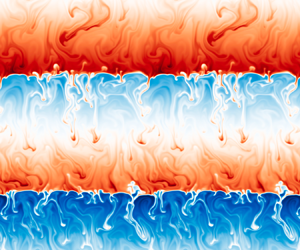Article contents
Settling-driven large-scale instabilities in double-diffusive convection
Published online by Cambridge University Press: 24 August 2020
Abstract

When the density of a gravitationally stable fluid depends on a fast diffusing scalar and a slowly diffusing scalar of opposite contribution to the stability, ‘double diffusive’ instabilities may develop and drive convection. When the slow diffuser settles under gravity, as is for instance the case for small sediment particles in water, settling-driven double-diffusive instabilities can additionally occur. Such instabilities are relevant in a variety of naturally occurring settings, such as particle-laden river discharges, or underground inflows in lakes. Inspired by the dynamics of the more traditional thermohaline double-diffusive instabilities, we ask whether large-scale ‘mean-field’ instabilities can develop as a result of sedimentary double-diffusive convection. We first apply the mean-field instability theory of Traxler et al. (J. Fluid Mech., vol. 677, 2011, pp. 530–553) to high-Prandtl-number fluids, and find that these are unstable to Radko's layering instability, yet collectively stable. We then extend the theory of Traxler et al. (2011) to include settling and study its impact on the development of the collective instability. We find that two distinct regimes exist. At low settling velocities, the double-diffusive turbulence in the fingering regime is relatively unaffected by settling and remains stable to the classical collective instability. It is, however, unstable to a new instability in which large-scale gravity waves are excited by the phase shift between the salinity and particle concentration fields. At higher settling velocities, the double-diffusive turbulence is substantially affected by settling, and becomes unstable to the classic collective instability. Our findings, validated by direct numerical simulations, reveal new opportunities to observe settling-driven layering in laboratory and field experiments.
Information
- Type
- JFM Papers
- Information
- Copyright
- © The Author(s), 2020. Published by Cambridge University Press
References
REFERENCES
- 7
- Cited by

